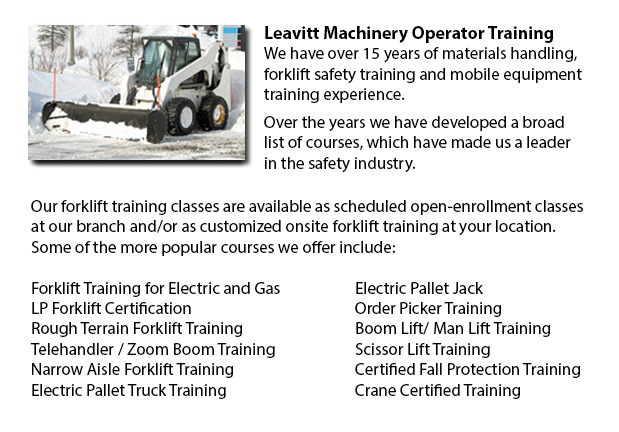
Barrie Skid Steer Ticket - The lift arms on the skid-steer loader are situated alongside the driver together with pivots at the rear of the driver's shoulders. These features makes the skid-steer loader different than the traditional front loader. Because of the operator's nearness to moving booms, early skid loaders were not as safe as conventional front loaders, specially throughout the operator's entry and exit. Today's' modern skid-steer loaders have many features to be able to protect the driver including fully-enclosed cabs. Similar to other front loaders, the skid-steer model can push materials from one site to another, is capable of loading material into a truck or trailer and could carry material in its bucket.
Operation
Usually a skid-steer loader could be used on a job location instead of a large excavator by digging a hole from the inside. To start with, the skid-steer loader digs a ramp leading to the edge of the desired excavation, and then it uses the ramp so as to excavate material out of the hole. As the excavation deepens, the machine reshapes the ramp making it longer and steeper. This is a particularly useful way for digging under a structure where there is not adequate overhead clearance for the boom of a big excavator. Like for example, this is a common situation when digging a basement below an existing home or building.
There is much flexibility in the attachments which the skid steer loaders are capable of. For example, the conventional bucket of many of these loaders can be replaced with several accessories that are powered by the loader's hydraulic system, consisting of mowers, snow blades, cement mixers, pallet forks, backhoes, tree spades and sweepers. Several other popular specialized attachments and buckets comprise trenchers, angle booms, dumping hoppers, wood chipper machines, grapples, tillers, stump grinders rippers, wheel saws and snow blades.
History
In the year 1957, the first front-end, 3-wheeled loader was invented in Rothsay, in the state of Minnesota by brothers Louis and Cyril Keller. The brothers invented the loader so as to help a farmer mechanize the method of cleaning turkey manure from his barn. This machine was light and compact and had a rear caster wheel which allowed it to maneuver and turn around within its own length, allowing it to perform the same tasks as a conventional front-end loader.
The Melroe brothers of Melroe Manufacturing Company in Gwinner, N.D. acquired during 1958, the rights to the Keller loader. The business then hired the Keller brothers to assist with development of the loader. The M-200 Melroe was the outcome of this partnership. This model was a self-propelled loader that was launched to the market in 1958. The M-200 Melroe featured a 12.9 HP engine, a 750 lb lift capacity, two independent front drive wheels and a rear caster wheel. By 1960, they replaced the caster wheel along with a back axle and introduced the first 4 wheel skid steer loader which was known as the M-400.
The M-400 shortly became the Melroe Bobcat. Normally the term "Bobcat" is utilized as a generic term for skid-steer loaders. The M-440 was powered by a 15.5 HP engine and had 1100 lb rated operating capacity. The business continued the skid-steer development into the mid nineteen sixties and launched the M600 loader.
-
Barrie Warehouse Forklift Safety Training
Barrie Warehouse Forklift Safety Training - Businesses normally face liability for injuries and damage sustained in workplace accidents. Warehouses can be hazardous places to the individuals who work there. That is the reason why employee safety is a... More -
Barrie Aerial Platform Training
Barrie Aerial Platform Training - Aerial lifts can accommodate many duties involving high and tricky reaching places. Normally used to carry out regular upkeep in buildings with high ceilings, prune tree branches, hoist heavy shelving units or mend p... More -
Barrie Forklift Ticket
Barrie Forklift Ticket - Pallet jacks and lift trucks are both intended for practically the same reason; to transfer goods from one location of your warehouse to another. This is basically where the comparison stops however. With the pallet jack, the... More -
Barrie Aerial Lift Training
Barrie Aerial Lift Training - An aerial work platform is a mechanized access platform. This machinery provides access to otherwise not accessible places for people or equipment. Also referred to as an aerial device or elevating work platform, the mac... More -
Barrie Aerial Boom Lift Training
Barrie Aerial Boom Lift Training - For people who operate or supervise the use of aerial lift platforms, correct aerial boom lift Training is required. The aerial lift platform is utilized for lifting individuals, tools and materials to elevated work... More -
Barrie Manlift Certification
Barrie Manlift Certification - The Elevated Platforms and Manlifts Certification program helps to provide the needed training on the work practices, safe operating procedures, rules and regulations regarding the everyday activities for the operators... More -
Barrie Overhead Crane Certification
Barrie Overhead Crane Certification - The overhead crane training certification course is designed to be effective with all participants regardless of literacy or language limitations. The course has two parts: a classroom training session and a prac... More -
Wheel and Track Loader Training in Barrie
Lift trucks are obtainable in several various units that have varying load capacities. The majority of typical lift trucks utilized in warehouse settings have load capacities of one to five tons. Bigger scale models are used for heavier loads, such a... More

Forklift Certification Barrie
TOLL FREE: 1-888-254-6157
Barrie, Ontario
forkliftcertificationbarrie.com
Email Us
About Us


